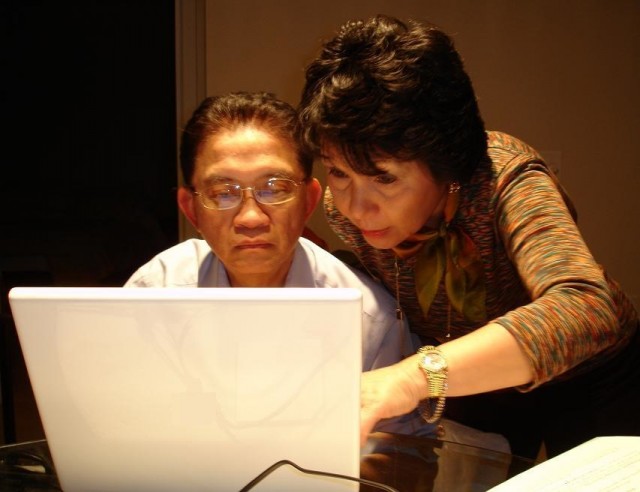As our homes and communities become more connected, people are expecting to find all their information online. How do associations and clubs make sure they are visible on the web.
This is the transcript of the opening keynote to the Australian Seniors Computer Clubs Association’s 2011 conference. The accompanying slideshow is available on Slideshare.
Reaching Connected Communities
Thank you very much for the kind introduction and the opportunity to open Australian Seniors Computer Clubs Association’s 2011 conference.
We’re in a time of history where all of us have the planet’s information at our fingertips and the ability to broadcast our own views and beliefs to the world.
Increasingly our roles as productive members of society are determined by our access to that information and our ability to use it.
Seniors computer clubs have a critical role in ensuring older generations have the opportunity to contribute to the connected society of the 21st Century.
The problem for clubs is that all of us struggle to be heard through the noise of the online world. This morning we’ll have a look at what tools computer clubs can use to stake their claim on the Internet and be found on the web.
It isn’t just clubs affected by this, many of the traditional models of media and business are struggling with these changes and this presents opportunities for computer clubs and community organisations.
Underlying the use of these tools there are the principles that I call the four C’s –community, collaboration, conversations and communications.
Communications
Of the four, communications is the most traditional area. We need to be talking to those who need our assistance.
We have to be telling people how we can help them, what our services are and of course when and where the clubs meet.
In a traditional way, we advertised, or had articles put into the local papers and other publications. These channels are evolving in the digital era and are important to clubs as the people you want to reach out to are those who aren’t using the web effectively.
We also have newer communications platforms in local search, mobile apps and social media.
All of these channels complement each other and allow us to post relevant and timely messages that keep members and the public up to date with key issues.
With search engines and social media now the main ways that people research and find information, it is more important than ever that clubs have a legitimate online presence.
Communications isn’t just about getting the message across, it’s also about working together and many of the cloud and social media tools like Google+, GoToWebinar and Webex allow us to have conversations with the housebound and dispersed groups.
Conversations
Traditional broadcast methods of communicating do not encourage conversations. If you want to have your voice heard in the local paper you have to write a letter to the editor which may take weeks to be published, if at all.
In reality there was no conversation. The owner of the printing press or broadcasting licence controlled the message and who was allowed in the discussion.
Today’s online tools today allow us to talk to our audience. This is a great advantage for community and volunteer groups.
This is something that big companies and governments, with respect to the minister, struggle with and it is where computer clubs and other community organisations will increasingly carry out an important role.
Collaboration
One of the traditional problems with volunteer groups is that much of the work fell on one or two individuals. The cloud computing tools of today mean groups can collaborate far better and take the load off key members.
Tools like Google Docs, Dropbox and WordPress mean that the load can be shared among a group and no longer has to rely on one person to update the website or complete meeting minutes.
These cloud computing tools allow clubs to work together better internally, improve efficiency and engage more effectively with their communities.
Community
The most important part of clubs is communities.
One of the problems we’ve seen in the 20th Century is that the rise of the motor car and broadcast media fragmented our communities.
Online tools, particularly social media, will work to bring communities back together, a process that’s going to accelerate as the era of cheap credit ends and the limitations of government are going to become apparent.
The tools
So what are the tools we can use for our clubs. I’m going to run through some basic ones. This is by no means a definitive list and you may find alternative tools that suit your organisation’s needs better.
These are listed on my website and at the end of my presentation I’ll give the web addresses to this presentation online so you don’t have to write down the scripts.
We’ll look at social media platforms, web publishing services and local search. First let’s look at the collaboration tools that help clubs deliver a better message to the community.
Google Apps
Google Apps, which is free for organisations with less than ten users, is a really handy service that offers basic word processing, spreadsheets and presentation software.
Its great strength is the ability to share those documents, spreadsheets and presentation with other users who can all work on them at the same time.
Google Docs also has a form feature which allows you to setup quick and ready surveys, feedback and booking forms.
Other similar tools are Zoho and Office365 which both offer collaboration and sharing features.
Dropbox
Dropbox, and its competitors Box.net and Microsoft’s SkyDrive, are great tools for sharing files between computers and collaborative teams.
These services allow you to create folders on an Internet service that you can then securely share with other people. It makes working on projects very easy and eliminates the shuffle of email attachments around groups.
If you are using these tools you don’t need to be converted about them.
Mailchimp
Mailchimp is the sanity saviour of small businesses and community organisations wanting to get newsletters out.
Managing a mailing list is hard work and these services take the hard work out of them as well as make sure your organisation complies with the spam act.
The service offers templates and sophisticated management tools so you can see who is opening your newsletters and what links they are clicking.
Survey Monkey
Survey monkey helps organisations keep in touch with their members and understand their needs. It’s a great tool for measuring customer satisfaction and feedback.
Google Apps has a more basic survey function built into it as well.
Both are excellent ways of keeping your membership in the loop when it comes to agreeing on new ideas.
Local Search
Local search is changing the way we do business.
Consumers using local as they abandon phone directories and classified ads as the net is a quicker more effective way of searching.
These local search results not only appear at the top of the page but they also feed into the popular social media services.
All organisations, local or otherwise should be listing on these not just to improve their search results but to also appear on other services and on devices like GPS systems.
If you have a relative or friend running a business I’d urge them to list on all of these services as this is an area that is seriously changing the business landscape.
Google Places
It is essential to be listed on Google Places as this will appear at the top of a local search and feeds into other social media and services like street directories and GPS navigators.
Ensure you fill in as many fields as possible, especially the times and days you are open and contact details.
Use the custom fields to improve your keywords and give a richer description of who you are.
You can also upload photos and videos which will improve your search results along with give visitors more information about what you do.
True Local
News Limited’s answer to Google Local ties into News’ local newspaper network.
True Local charges for some functions that are free in Google Places and offers additional free services like the ability to upload Word and PDF documents.
Sensis
Sensis is digital roadkill, the most common complaint with the print edition now is that it’s too small to read and the phone book doesn’t make a good monitor stand anymore.
However, Sensis’ free listing is important as it feeds into NineMSN’s search which is the default on Windows computers.
You’ll also receive a free listing in the printed Yellow Pages for what it’s worth, which to be fair is probably where the most digitally challenged folk will find you.
Social Media
In recent years we’ve been lead to believe that social media is something bigger than the industrial revolution that will cure various tropical diseases, rescue broken business models and make a cup of tea for you in the morning.
The reality is social media is changing the way communities and markets communicate. It’s the 21st Century’s town square or village tavern.
Social media services are great for driving traffic to your site and excellent for listening to trends, monitoring news and talking to your community. They are also the greatest driver for people getting online.
Facebook
Contrary to stereotypes, the fastest growing group among Facebook’s 800 million users are seniors.
This is the biggest opportunity for clubs as the late adopters – the sceptics who’ve resisted going online are now doing so, if only to talk to their grandkids.
There’s a view that Facebook, and most other social media services, are for teenagers putting up pictures of cats and talking about what they did last weekend. That’s wrong on many levels as the service cuts across all demographics and groups.
Facebook Pages
Like a Google Places page, a Facebook Page is free and vital to clubs and businesses. If you have relatives running a business, they should also sign up for a free site.
Increasingly this is where the public goes to online and we have to be there. You can also add events and publicise them through these pages. Your community can contribute and share to your page.
Get 25 members to like your page and you can claim the full name as well.
Google+
Like Facebook, Google+ has a free pages function for community groups and pages. However it remains to be seen how much traction Google+ will get as the service develops.
Google itself seems to be confused about what Google+ actually is, Eric Schmidt, Google’s chairman, calls it an identity service rather than a social media platform. This confusion of what Google Plus actually is doesn’t fill me with optimism on the service’s future.
Apart from the social aspect, Google+ has some interesting collaboration tools such as Hangouts, that allow ten people to work together. If you have a webcam installed, and most new systems come with one, you can set up a group for training or collaboration.
Along with Google+ there are other webinar programs such as GoToWebinar or Webex and Skype’s conferencing feature does a very job at this as well.
Twitter
As a conversational and listening tool Twitter is excellent, although it has been largely mis-sold by the social media business community as a marketing and PR tool.
Twitter allows you to be ahead of the news cycle as most journalists use it to find stories. My own use of Twitter is as a news source.
It’s a good way of keeping up to date on what is happening in communities and with connecting with individual journalists and opinion makers.
Own your platform
The website is your site and your property. Overlooked the dangers of not owning the space you are publishing on.
Websites have become easier to use and build. It you’re using a service like Blogger or WordPress you can get a site running for as little as seven dollars a year and you can be delegating access to various members of the group.
Your website is the centre of your online presence and your home base in the digital economy.
Blogger
Blogger – Google’s free blogging service – is a great tool for getting a website running.
Easy to use, with dozens of templates and plugins for services like e-commerce, newsletters, social media and events it’s an effective and quick way to get a website running.
You can also use your own business domain name for free. Which means you can get online for under $50 a year.
WordPress
WordPress is the most popular web content management system. Offering a vast number of templates and plug ins with the advantage of a big community of developers to support the product.
The software also allows an easy upgrade path to other services like Drupal.
Not business as usual
This is not business as usual.
Many of our business and political users are locked into 1980s ideologies and business models that are rapidly being challenged.
In the media we have a whole generation of journalists who are seeing their careers being twisted out of shape by forces they don’t recognise, something that has already happened to the record industry that thought it could use the old business model of developing new technologies that would extend their playlists in the way the LP had in the 1970s and CD in the 1980s.
We see this in the consumer goods industries where old business models are being challenged.
Earlier this year Bernie Brooks, the chief executive of Myer, signed a deal with one of China’s biggest contract manufacturers to make Myer’s homebrand clothes.
The problem with this is it’s the 1980s model. Today consumers can research these things and they will quickly figure out that Myer’s $200 branded shoes are made in the same factory and little different from those you can by for $50 at Target or Lowes.
This mindset illustrates the problems of established businesses and it’s no problem that Coles and Harvey Norman are campaiging to obstruct online shopping in an environment where the informed consumer is able to circumvent the old distribution and retail models.
In many ways these are modern equivalents of the stagecoach operators and it’s no co-incidence that a hundred years ago this year that Cobb & Co went broke. This is risk that any business runs when it is unfortunate to have managers who ignore trends.
Addressing the digital divide
Seniors computer clubs have an important part in today’s society.
The real digital divide is not across age, it is not between “digital natives” and “digital immigrants”, the real divide is between those who are prepared to understand and use these online tools and those who won’t.
Those who won’t are going to be increasingly isolated from a world that is going online. At a time where we’re seeing the NBN rolled out, the launch of 4G networks and increasing use of the web by business and government agencies it’s going to be essential to have some knowledge of the online world and the tools to use it.
Being on the wrong side of the divide will make it increasingly hard to access services and information.
The role of groups like the local seniors’ computer group is to help people remain valued and productive members of our community in today’s connected society.
Hopefully I’ve given you some ideas this morning on how to carry out the important role you have in this decade of great change.
Similar posts:












